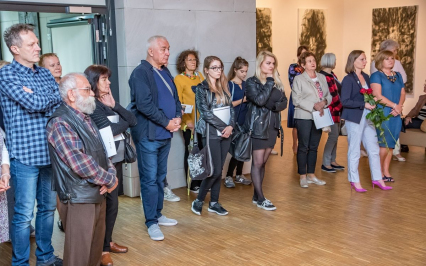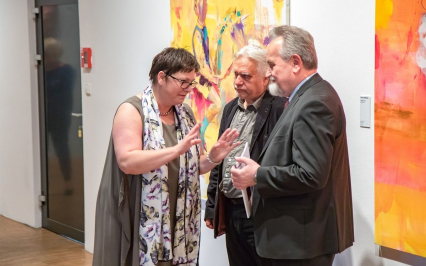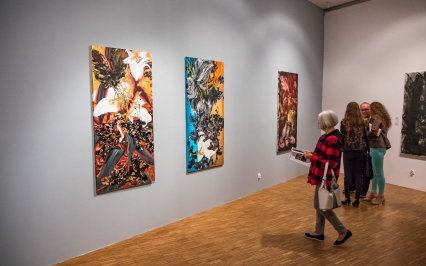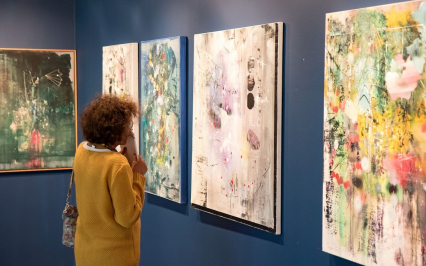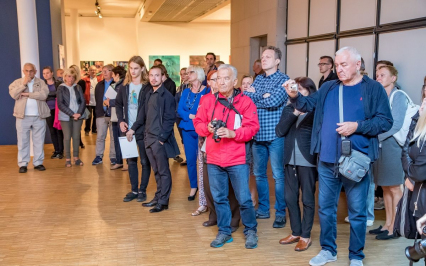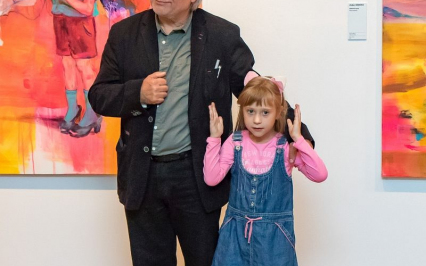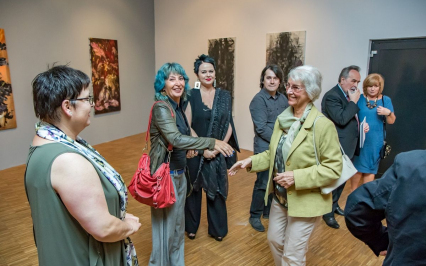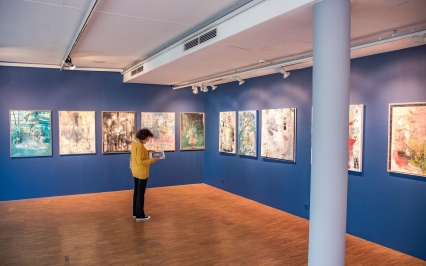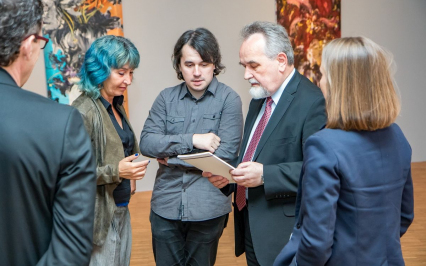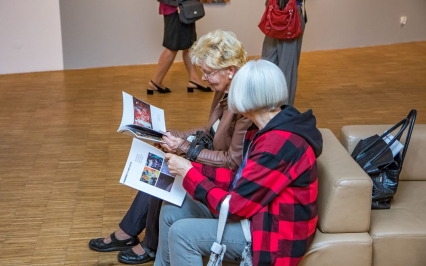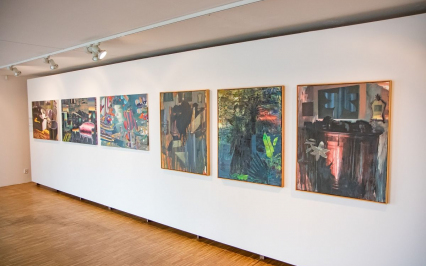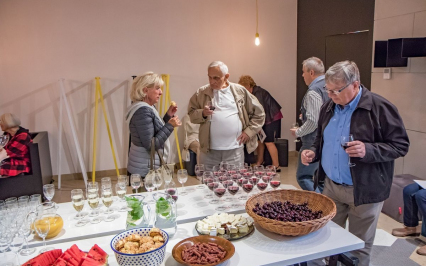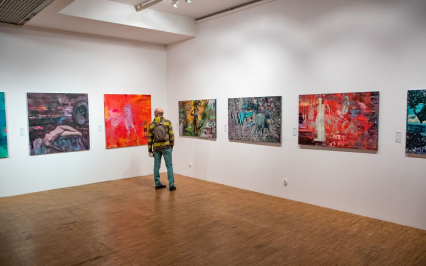post utopia
22 June - 29 July 2018
BWA SOKOL
vernissage:
22 June 2018, hour 18:00
This is not the first exhibition that Ioana Antoniu, Adriana Elian, Andor Kőmives and Radu Pulbere organize together. However, this is the first time that their group presence underlines how reality has changed in more than twenty years.
This is not the first exhibition that Ioana Antoniu, Adriana Elian, Andor Kőmives and Radu Pulbere organize together. However, this is the first time that their group presence underlines how reality has changed in more than twenty years. These four artists became one of the most valuable centers of contemporary painting in Cluj, as their means of artistic expression gradually reached maturity, merging simultaneously with artistic identity - different in each of them. We are talking above about "modern painting in Cluj" to distinguish them from painters born in Cluj, or those who lived there for a while, but treat the city as a temporary stop on the road, not a permanent place of residence.
Although each of the artists aspires to be original, the originality would not be enough if their works were not outstanding also in the aspect of sublimation of communicated content. In addition, although the works of each artist from the four have a distinct, individual style, as a witness to their evolution, I managed to identify certain characteristics of their creative path, showing that they have become a role model.
It is worth mentioning - especially for those who want to devote themselves to the artist's career - that it required a lot of dedication, consistency, persistence and hard work over several decades. You could say that Ioana Antoniu, Adrian Elian, Andor Kőmives and Radu Pulbere are the most consistent and consistent artists in the history of Cluj, active in their workshops and outdoors, receptive to new ideas and concepts, drawn from the largest international exhibitions and the latest critical studies. In addition - which testifies to their typical generosity - they also devote time and energy to teaching at the University of Fine Arts and Design, with professional involvement and for the benefit of many generations of students. After seeing the works selected for this exhibition, I have no doubt that we are dealing with artistic personalities who came to live not only at the turn of two historical epochs but also during the socio-political transformation they had to deal with, re-inventing strategies actions.
Transformation allowed Romanian artists to contact with Western creative environments that were beyond their reach during communism. The crisis of painting is one of the main trends characterizing the generation of our four artists, manifesting itself either to abandon painting, or to add other options - such as photography, video or installations - from the repertoire of new media popular in the West.
However, this is not the case of our four artists. They remain faithful to painting, trying to discover new possibilities to reflect the new reality. They invariably cultivate their interest in figurative painting, but not in the "retinal painting" version, in the coordinates of time and space. On the contrary, they have developed a lyrical discourse that uses metaphors and hyperbole, while avoiding painting as a narrative or literary-illustrative role. Their painting exists in isolation from circumstances, denotation or aestheticisation, but at the same time has visible connotations. Artists seek, among other things, to seek meaning and meaning in things that hide complex phenomena under their visible layer. Their work, often mysterious, is not so much a sensationalist one, but rather a hermeneutic attempt to refer to psycho-social problems, they are a look into the psychological abyss.
Another feature connecting all four is a consistent search for a dimension that combines the image with the reflection, which led to polymorphic trajectories not limited to the recipe for success, as is often the case of artists who remain faithful to the "designated" territory, especially for commercial reasons . Their work has evolved organically - without speeding up any of the stages, while new content results from the roots and premises present in previous stages of creativity.
Finally, the artists themselves mention the pace of their creative activity, testifying to a deep vocation, a momentum that probably turned out to be stronger than other reflexes and skills shaping behaviors. Their exhibitions have always been a revelation for artistic circles, and especially for those who have been their students over the decades. This exhibition presents their works to the public, who had the opportunity to see some of their work in 2014, during an exhibition dedicated to the phenomenon of the Academy of Fine Arts in Cluj. Ioana Antoniu, Adriana Elian, Andor Kőmives and Radu Pulbere played a significant role in her international success - not only as lecturers.
Călin Stegerean
Although each of the artists aspires to be original, the originality would not be enough if their works were not outstanding also in the aspect of sublimation of communicated content. In addition, although the works of each artist from the four have a distinct, individual style, as a witness to their evolution, I managed to identify certain characteristics of their creative path, showing that they have become a role model.
It is worth mentioning - especially for those who want to devote themselves to the artist's career - that it required a lot of dedication, consistency, persistence and hard work over several decades. You could say that Ioana Antoniu, Adrian Elian, Andor Kőmives and Radu Pulbere are the most consistent and consistent artists in the history of Cluj, active in their workshops and outdoors, receptive to new ideas and concepts, drawn from the largest international exhibitions and the latest critical studies. In addition - which testifies to their typical generosity - they also devote time and energy to teaching at the University of Fine Arts and Design, with professional involvement and for the benefit of many generations of students. After seeing the works selected for this exhibition, I have no doubt that we are dealing with artistic personalities who came to live not only at the turn of two historical epochs but also during the socio-political transformation they had to deal with, re-inventing strategies actions.
Transformation allowed Romanian artists to contact with Western creative environments that were beyond their reach during communism. The crisis of painting is one of the main trends characterizing the generation of our four artists, manifesting itself either to abandon painting, or to add other options - such as photography, video or installations - from the repertoire of new media popular in the West.
However, this is not the case of our four artists. They remain faithful to painting, trying to discover new possibilities to reflect the new reality. They invariably cultivate their interest in figurative painting, but not in the "retinal painting" version, in the coordinates of time and space. On the contrary, they have developed a lyrical discourse that uses metaphors and hyperbole, while avoiding painting as a narrative or literary-illustrative role. Their painting exists in isolation from circumstances, denotation or aestheticisation, but at the same time has visible connotations. Artists seek, among other things, to seek meaning and meaning in things that hide complex phenomena under their visible layer. Their work, often mysterious, is not so much a sensationalist one, but rather a hermeneutic attempt to refer to psycho-social problems, they are a look into the psychological abyss.
Another feature connecting all four is a consistent search for a dimension that combines the image with the reflection, which led to polymorphic trajectories not limited to the recipe for success, as is often the case of artists who remain faithful to the "designated" territory, especially for commercial reasons . Their work has evolved organically - without speeding up any of the stages, while new content results from the roots and premises present in previous stages of creativity.
Finally, the artists themselves mention the pace of their creative activity, testifying to a deep vocation, a momentum that probably turned out to be stronger than other reflexes and skills shaping behaviors. Their exhibitions have always been a revelation for artistic circles, and especially for those who have been their students over the decades. This exhibition presents their works to the public, who had the opportunity to see some of their work in 2014, during an exhibition dedicated to the phenomenon of the Academy of Fine Arts in Cluj. Ioana Antoniu, Adriana Elian, Andor Kőmives and Radu Pulbere played a significant role in her international success - not only as lecturers.
Călin Stegerean
Vernissage
On 22 June 2018, the vernissage of the POST UTOPIA exhibition took place. We invite you to view photos.




